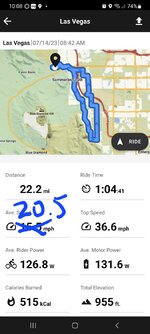AntonioAlfaro
Active Member
- Region
- Other
hello mtnroadsHave never used power pedals, but I find it rather interesting that despite the watts being all over the place during my rides (both rider and system watts), when I return from a ride and look at the average watts displayed in the Trek Dashboard ride summary - the sum of the two figures (rider/system) is within a few watts of what Strava tells me was expended for the ride. Yesterday it was within ONE watt. Two completely different systems and ways of deriving the number. Strava uses the actual route with known elev gain, time, heart rate (for effort) and rider weight, to get to it's number. I don't think it knows much about localized wind conditions. Obviously the bike measures what the bike and I are actually putting in.
For them to be so close tells me the Trek number must be fairly accurate. There has only been one exception - on my first ride, Strava was low by 15 watts - but I had a very strong headwind without a compensating tailwind, and I also had not told Strava it was an e-bike ride.
The speed and range continue to impress, being at least as good as Trek estimates, but tuning through the app is still a crapshoot and I am never really sure why I get exactly what I do in the various modes, other than of course MAX contributes more than ECO or MID. Still figuring it out.
Thank you for your feedback, in fact the optimal adjustment of the assistance levels is a task that can be complicated if we do it by trial and error without following any methodology.
I've been cycling all my life, but I'm a little old now and also a cancer survivor.
Despite using an 8Kg BMC Roadmachine bicycle, I decided to incorporate an Ebike to be able to keep up with the young people that make up my cycling group.
For many years I have used pedals with power meters on both sides and I know very well what my FTP is.
When I bought my Orbe Gain D50 ebike I developed a methodology to optimally customize the assistance levels, that methodology is a very good approximation.
I have ordered a Domane+ SLR6 that I expect to receive in a couple of months, and my plan is to adapt and verify the methodology with Domane+ SLR.
Meanwhile I continue to feed on all the experiences that are reported in this forum and all the information available about Domane+ SRL.

